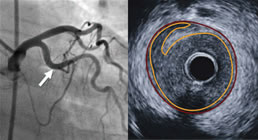|
Such is the conclusion of a new study by researchers at the Cardiac & Vascular Institute at NYU Langone Medical Center. And this type of non-obstructive myocardial infarction seems to happen more frequently in women than in men.
The research team, led by Dr. Harmony Reynolds of NYU Langone, investigated the origin of heart attacks in fifty women with "normal" coronary arteries, as seen on angiography. Using intravascular ultrasound (IVUS), they found that almost 40% of the women showed evidence of plaque disruption -- something that cannot be seen on an angiogram. When the results of cardiac magnetic resonance (CMR) imaging were added, 70% of the women were found to have abnormalities not detectable during angiography. As shown by the PROSPECT study of over 700 patients, published in the New England Journal of Medicine in January, IVUS was been able to identify so-called "vulnerable plaques" that are invisible on angiograms. Dr. Reynolds opined that her study "knitted together" some of the PROSPECT results. She commented to Angioplasty.Org:
"We know from PROSPECT that lesions that are ultimately going to be culprits were non-obstructive and looked vulnerable on IVUS.... Angiography unfortunately doesn't tell the whole story and I think IVUS is a fantastic tool to be able to learn more about the artery wall in all kind of conditions. And this MI with non-obstructive disease is definitely one of them." Dr. Reynolds' thoughts are that it is possible that these plaque disruptions may cause a thrombosis, especially in women, because of hormonal and other gender-specific differences, but that the body then lyses this thrombotic blockage naturally and, by the time the patient is in the cath lab, the blockage is gone...but the heart attack is very real. Women who have had a heart attack and have normal or near-normal angiogram results may be told they didnt have a heart attack at all because of the angiogram result, said Reynolds. Our study shows the benefit of additional imaging to find a plaque disruption when it occurs and correctly diagnose the reason for heart attack in these women.The clinical and treatment implications of this study are significant because many heart attack patients without angiographically obstructive coronary artery disease may go undiagnosed and not receive the necessary heart medications like antiplatelet drugs and statins -- lifesaving tools against future cardiac events. Dr. Reynolds continued: About the Intravascular Guidance Center on Angioplasty.Org To assist in educating the professional and patient population in the U.S. about these new imaging, measurement and therapetic techniques, Angioplasty.Org created the "Intravascular Guidance Center" in 2006: a special section which is devoted to information and news for both patients and physicians about intravascular ultrasound (IVUS), fractional flow reserve (FFR), optical coherence tomography (OCT) and other intravascular modalities. The Intravascular Guidance Center features overview articles, the latest news and interviews with leading practitioners of these techniques, such as Drs. Antonio Colombo, John McBarron Hodgson, Augusto Pichard, William Fearon and Nico Pijls. This special section receives support from Volcano Corporation.
Reported by Burt Cohen, October 6, 2011 |



